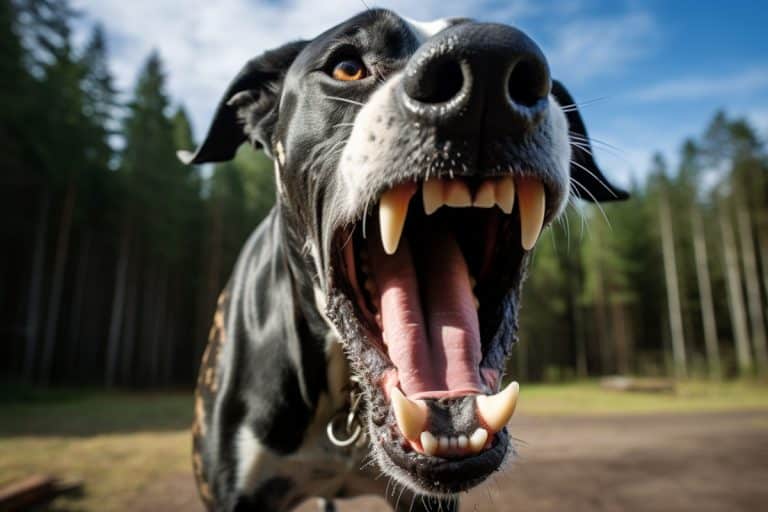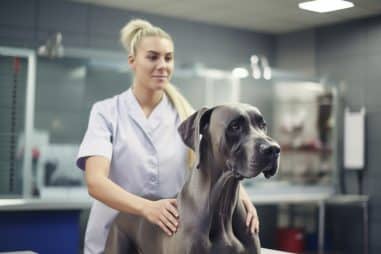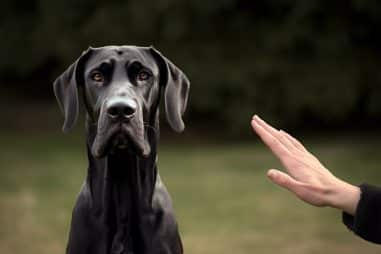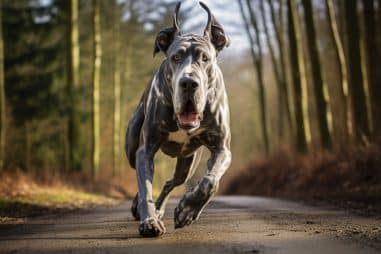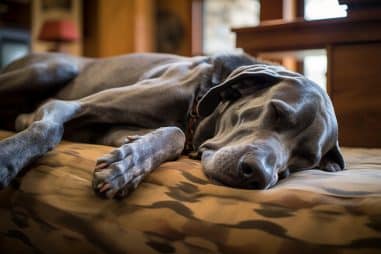The Great Dane is a breed that easily captures attention wherever it goes. With its towering size and majestic stride, it’s a true icon of the canine world. Often, onlookers and potential dog owners wonder if such a giant breed carries aggression and danger in its genes. Understanding the temperament and behavior of the Great Dane is crucial for fostering a safe and harmonious environment both for the dogs and the people around them.
Historical Background of the Great Dane
The tale of the Great Dane’s aggression is a narrative entwined with its historical evolution. Originating from a lineage of robust and ferocious boar hounds, the Great Dane’s past is painted with strokes of valor and ferocity. However, as the sands of time shifted, so did the temperamental traits of this majestic breed, morphing from a ferocious hunter to a gentle companion.
In ancient times, the ancestors of today’s Great Dane were bred for their hunting prowess, tasked with chasing down and holding at bay wild boars, a dangerous game that demanded both aggression and physical strength. The Great Dane’s ancestors were selected for their fearlessness and their capability to engage with dangerous prey, traits essential for survival in a harsh, unpredictable environment.
As civilization progressed, the need for such aggressive traits in dogs diminished. The roles of dogs within human society evolved from hunters and protectors to companions and helpers. The breeding focus for Great Danes shifted accordingly, moving away from aggression towards more gentle, sociable traits. Breeders began selecting for temperament, favoring those dogs that exhibited a calm demeanor, loyalty, and an ability to get along well with humans and other animals.
With each passing generation, the aggressive tendencies once prized in the breed were further diluted, giving rise to the gentle, affectionate Great Dane we are familiar with today. This transformation wasn’t accidental but a result of meticulous breeding practices aimed at nurturing the breed’s friendly and protective nature.
However, remnants of their historical roles can still surface today. For instance, Great Danes can be protective and may exhibit guarding behaviors, especially in situations where they perceive a threat to their loved ones. Yet, with proper socialization and training, any residual protective instincts can be channeled in a positive, controlled manner.
The journey from ferocious boar hounds to gentle giants elucidates the remarkable evolution of the Great Dane’s temperament. Today’s Great Dane is a testament to how selective breeding can dramatically alter the temperament of a breed over time, turning a once fearsome hunter into a loving family companion. The historical aggression associated with the breed has become a mere shadow, overtaken by the gentle, affectionate nature that now defines the Great Dane.
Physical Characteristics Related to Perception of Aggression
The sheer size of a Great Dane, which can reach up to 34 inches (86 cm) at the shoulder and weigh as much as 200 pounds (90 kg), often sets a premise for intimidation. Their deep barks can send shivers down one’s spine, and when they stand on their hind legs, they are tall enough to look a grown man in the eye. However, these physical traits, though imposing, don’t translate to aggression. In fact, they are often dubbed as gentle giants due to their calm and friendly demeanor.
Temperament and Behavior
Great Danes are among the gentlest of breeds. They are known for their loyalty, affection, and keen sense of companionship. They thrive on human interaction and are happiest when they are part of family activities. However, like any dog, they can become aggressive in threatening situations or if not socialized properly. It’s essential to recognize that a well-trained and socialized Great Dane is a loving and safe companion. Unwanted behaviors are often the result of neglect, lack of training, or improper socialization rather than an inherent temperament issue.
Behavioral Problems and Solutions
Occasionally, Great Danes may exhibit behavioral problems like excessive barking, chewing, or even aggression. Early intervention through training and socialization can correct these issues. It’s vital to introduce your Great Dane to various people, animals, and environments at a young age to foster a well-rounded temperament. Providing a structured, loving environment and consistent training will allow your Great Dane to become the gentle companion they are meant to be.
Training and Socialization
Training and socialization are paramount for any dog breed, but they hold special significance when it comes to large breeds like the Great Dane. These gentle giants are known for their friendly and affectionate nature, yet, like any dog, they can exhibit undesirable behaviors if not properly trained and socialized. Curbing aggression and fostering a well-rounded temperament involves a mix of early intervention, consistent training, and positive exposure to a variety of experiences.
Start Early
Early training and socialization are the cornerstones for raising a well-behaved Great Dane. Puppies are like sponges, eager to learn and absorb the world around them. This early period is the perfect time to introduce your Great Dane to basic obedience training. Simple commands like sit, stay, and come are the building blocks for more advanced training later on.
Positive Reinforcement
Utilizing positive reinforcement techniques is crucial. Rewarding your Great Dane with treats, praise, or playtime whenever they exhibit good behavior encourages them to repeat those behaviors. It’s a constructive way to build a strong bond between you and your dog, and to foster a positive learning environment.
Exposure to Varied Environments
Socialization entails exposing your Great Dane to a variety of people, animals, and environments. The goal is to make them comfortable with the world around them. A well-socialized Great Dane is less likely to react aggressively to new or unfamiliar situations. It’s beneficial to introduce your Great Dane to different settings, noises, and individuals, ensuring they become well-adjusted adults.
Group Training Classes
Enrolling in group training classes can be a boon for both socialization and training. It not only provides a structured environment for learning but also exposes your Great Dane to other dogs and people. This interaction is invaluable for curbing aggressive tendencies and promoting social behavior.
Addressing Aggression
If aggressive behavior does surface, it’s crucial to address it immediately. Consulting with a professional dog trainer or a behaviorist can provide insight into the cause of the aggression and offer strategies for managing and correcting the behavior.
Patience and Understanding
Patience and understanding are your allies on this journey. Every dog is unique, with its own learning pace and personality. Celebrate the small victories and keep a positive outlook as you work together with your Great Dane towards fostering a harmonious, aggression-free companionship.
Through diligent training and thorough socialization, the innate gentle temperament of the Great Dane shines through, dispelling shadows of aggression and fear. Your efforts in nurturing a well-trained and socialized Great Dane will reward you with a loyal, loving, and gentle companion.
Health Factors Influencing Behavior
Like any breed, Great Danes have their share of health issues. Conditions like hip dysplasia or certain neurological conditions can cause discomfort or pain, which in turn, might affect their behavior. A Great Dane in pain may become irritable or fearful, which can lead to aggressive tendencies. Regular checkups with a vet and prompt attention to any health issues can prevent behavioral problems stemming from health conditions.
Legal and Insurance Implications
Owning a Great Dane, or any large breed, comes with its own set of legal and insurance considerations. Given their size and potential to cause harm, albeit unintentionally, it’s imperative to be well-versed with the legal landscape surrounding Great Dane ownership and the insurance protections that should be in place.
Breed-Specific Legislation (BSL)
Breed-Specific Legislation is a legal framework in some regions that imposes restrictions or bans on certain breeds perceived as dangerous. While Great Danes are not commonly targeted by BSL, it’s essential to check the local laws in your area to ensure compliance. BSL can cover a range of stipulations, from mandatory microchipping and neutering to imposing leash and muzzle requirements in public places.
Licensing and Registration
Most regions require dog owners to license their pets. This process often involves providing proof of rabies vaccination and may also entail a nominal fee. Ensuring your Great Dane is properly licensed and registered not only keeps you on the right side of the law but also helps in the identification and safe return of your pet should they get lost.
Liability Insurance
Given the potential for accidents due to their size, having liability insurance is prudent for Great Dane owners. Liability insurance can cover medical costs and legal fees if your dog injures someone or causes property damage. Some homeowners or renters insurance policies offer liability coverage for pets, but it’s crucial to confirm the specifics, including any breed restrictions or coverage limits.
Fenced Yards and Containment
Local ordinances may have stipulations regarding the containment of large breeds. Having a securely fenced yard can provide a safe space for your Great Dane to exercise while also keeping you compliant with local regulations.
Microchipping
Microchipping is a simple procedure that can have significant legal and practical benefits. In some areas, microchipping is a legal requirement for dog owners. Additionally, a microchip can be a lifesaver in locating and identifying your Great Dane should they ever get lost.
Navigating the legal and insurance landscape as a Great Dane owner may initially seem daunting. However, with due diligence and proper preparation, you can ensure a happy, healthy, and lawful environment for your gentle giant to thrive. Being well-informed and proactive in addressing legal and insurance considerations is the hallmark of responsible Great Dane ownership, paving the way for a smooth and enjoyable companionship with your majestic companion.
Conclusion
Great Danes are magnificent creatures with a temperament that contradicts their intimidating size. With proper training, socialization, and care, they make loving and loyal companions. The perception of aggression and danger surrounding Great Danes largely stems from misunderstandings and a lack of knowledge. As a potential or current Great Dane owner, investing time in understanding and nurturing your dog will ensure a peaceful and enjoyable companionship, debunking the myths of aggression tied to this noble breed.

